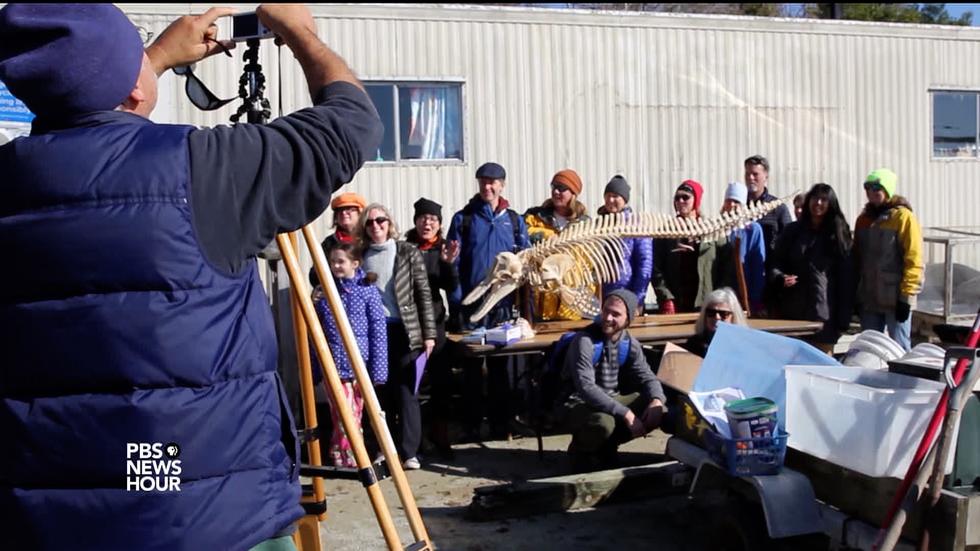(单词翻译:单击)
听力文本
Judy Woodruff: We close with a different look at ocean life, how a group of citizen scientists use a dolphin graveyard to uncover how the majestic mammals live. The NewsHour's Teresa Carey traveled to North Carolina to bring us tonight's edition of a NewsHour shares.
Teresa Carey: Keith Rittmaster, curator at the North Carolina Maritime Museum, leads 14 volunteers into the woods to a place he calls the dolphin graveyard. They plan to dig up the remains of a bottlenose dolphin named Moe. Rittmaster discovered Moe three decades ago during a photographic survey of dolphins in the wild. He takes photos of their dorsal fins. Each notch, scar, and blemish is a unique fingerprint that allows scientists to identify individual animals. Rittmaster has tracked dozens of dolphins this way. He spent years following Moe across his 100-mile habitat from Nags Head to Cape Lookout. Keith Rittmaster: This catalogue contains one photo from every day that we have documented Moe, from 1992, and ending before he died on February 27, 2016.

Teresa Carey: The North Carolina Marine Mammal Stranding Network's Vicki Thayer was among the first on the scene the day Moe passed away.
Vicki Thayer: So we arrived and examined the animal for a necropsy.
Teresa Carey: This necropsy, an animal autopsy, gives insight into how Moe died.
Vicki Thayer: Moe had been entangled in some kind of fishing monofilament line, and so that was the likely cause of death.
Teresa Carey: Over 300,000 whales and dolphins die globally from entanglements each year, like this dolphin Rittmaster found in 2011.
Keith Rittmaster: It wasn't until we prepared the skull that we could tell that the bone actually had grown around that fishing line that was killing it.
Teresa Carey: Rittmaster's collection is one of the most thorough in the state. He has whale teeth, an ear bone from a baby dolphin, and even ribs from a humpback whale. But his prized artifacts are reconstructed skeletons, many of which are one of a kind. Thayer gathers autopsy information on each beached animal, then helps Rittmaster bury them in his dolphin cemetery. Once two years pass, he assembles a crew of volunteers to exhume the skeleton. Exhuming Moe presents a rare opportunity for understanding the animal's entire life and death. Scientists can use the teeth to determine age and the bones to understand some diseases.
K.C. Bierlich: For older animals, you can see that the bones are fused together more, and so that kind of tells you a lot about the animal, what stage of life it was when it passed away.
Teresa Carey: It takes four hours to exhume, catalogue, and clean Moe's entire skeleton.
Vicki Thayer: My hope is that what we're learning today can build and help animals in the future.
Teresa Carey: Even though it's a graveyard, there is an overall feeling of optimism.
Vicki Thayer: If it weren't for stranded animals, we wouldn't know very much about them at all.
Teresa Carey: Moe's completed skeleton will take two years to assemble. It'll be on display at the North Carolina aquarium Jennette's Pier in Nags Head in 2019. For the PBS NewsHour, I'm Teresa Carey in Beaufort, North Carolina.
重点解析
1.close with a different look at 以不同视角
We close with a different look at ocean life.
我们对海洋生活的看法各不相同。
2.pass away 去世/消失
Time is speeding up in your perceptions to help you realize that even this shall pass away.
你感知里的时间在加速,来帮助你认识到它甚至会消失。
3.prized artifacts 珍贵的文物
The agreement resulted from a request by the Greek government for help in protecting its prized artifacts.
这项协议是应希腊政府的要求为帮助保护珍贵的希腊文物而达成的。
4.dig up 挖掘
You would have to dig up the plant yourself.
你得自己把那株植物挖出来。
参考译文
朱迪·伍德瑞夫:我们对海洋生活的看法各不相同,平民科学家结组探访海豚墓地,为您揭示这一伟大哺乳动物的生活秘密。特丽莎·凯瑞前往北卡罗莱纳州,为您报道。
特丽莎·凯瑞:北卡罗莱纳海事博物馆馆长基思·瑞迪马斯特,带领14名志愿者前往一片树林,那是一个他称作“海豚墓地”的地方。他们计划在那里对宽吻海豚莫伊的遗体进行挖掘。三十年前,瑞迪马斯特在一次野生海豚摄影勘察中发现了莫伊。他拍摄了那些海豚的背鳍照片。每一个划痕、伤疤和小瑕疵都是独特的印记,这些印记可以让科学家们认出它们谁是谁。瑞迪马斯特用这种方式对几十头海豚进行了追踪。他花了几年时间追踪莫伊,从它100英里外的栖息地纳格斯黑德直到瞭望角。
基思·瑞迪马斯特:从1992年到莫伊2016年2月27日去世,我们每天给它拍一张照片,记录下来,这是目录清单。
特丽莎·凯瑞: 北卡罗莱纳海洋哺乳动物搁浅系统的维姬·塞耶是最先发现莫伊去世的人之一。
维姬·塞耶:我们赶到那,对莫伊进行了尸体剖检。
特丽莎·凯瑞:这次剖检是一次动物剖检,从中我们可以知道莫伊的死因。
维姬·塞耶:莫伊是被某种钓鱼线缠住了,这很可能就是死亡原因。
特丽莎·凯瑞:和瑞迪马斯特2011年发现的这只海豚一样,每年有超过300,000只鲸鱼和海豚死于各种“缠绕”。
基思·瑞迪马斯特:直到我们解刨开它的颅骨,才看出,头骨四周有很多鱼线,也正是这些鱼线要了它的命。
特丽莎·凯瑞:全国来讲,瑞迪马斯特的收藏非常丰富。他藏有鲸鱼的牙齿,海豚宝宝耳骨,甚至还有座头鲸的肋骨。但他这些珍贵的文物都是重组的骨骼,很多都是一样一种。塞耶收集每个搁浅动物的解剖信息,然后帮瑞迪马斯特将它们埋到海豚墓地。每两年,他都会召集志愿者一起去挖掘海豚骸骨。莫伊骸骨的挖掘为我们提供了一个难得的机会,让我们了解海豚的整个生命过程以及它们的死亡。科学家可以利用动物牙齿,来确定它们的年龄和利用骨骼,了解一些动物疾病。
K.C. 比尔丽驰:对于年龄较大的动物,你可以看出,它们的骨头更多地融合在了一起。所以这样我们就了解了,某只动物死时处在什么生命阶段了。
特丽莎·凯瑞:莫伊骨架的发掘,录入和整理过程需要持续四个小时。
维姬·塞耶:我希望我们今天了解到的东西,可以在将来帮到这些动物。
特丽莎·凯瑞:虽然这里是个墓地,但给人的整体感觉仍然是积极向上的。
维姬·塞耶:要不是这些被困的动物,我们根本不会对它们有深入了解。
特丽莎·凯瑞:莫伊完整骨架的组装将需要两年的时间,将于2019年,在纳格斯黑德北卡罗莱纳水族馆詹尼特码头进行陈列。PBS NewsHour,我是特丽莎·凯瑞,从北卡罗莱纳博福特发回报道。
译文为可可英语翻译,未经授权请勿转载!


